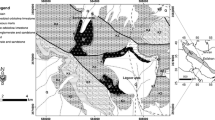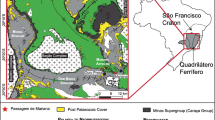Summary
Quartz-tourmaline vein-hosting rocks of the Okote area belong to the Neoproterozoic Adola Belt. Metasomatic auriferous quartz-tourmaline veins occur in ductile N–S trending, sinistral shear zones. These veins commonly contain quartz, carbonates, and tourmaline, with minor pyrite, and accessory chalcopyrite, pyrrhotite, and gold. Tourmaline forms isolated euhedral crystals in the fracture surfaces of quartz carbonate veins. Many of the tourmaline crystals are optically zoned with a bluish core and a bluish to brown rim. Electron microprobe analyses show that the tourmalines comprise an intermediate dravite-schorl solid solution with a mean FeO/(FeO + MgO) = 0.47. Abrupt transitions between the colour zones within single tourmaline crystals are accompanied by relative variations in the FeO/(FeO + MgO) ratios. The tourmaline separates indicate that the tourmalines contain highly variable average contents of trace elements. Chondrite-normalized rare earth element (REE) abundances of tourmaline separates from auriferous veins show LREE-enriched to LREE-depleted patterns with negative to positive Eu anomalies and a flat, near-chondritic HREE pattern. The auriferous quartz-tourmaline veins have LREE-enriched patterns without a Eu anomaly and a flat HREE pattern, but tourmaline-free gold-quartz veins have very low REE contents and LREE-depleted patterns also without Eu anomalies. The FeO/(FeO + MgO) ratios, major and trace element compositions, and the types of wall-rock alteration are used to suggest that the sources of boron are dominantly metamorphic (dehydration and devolatilization processes), but do not totally exclude the possibility of a magmatic source. The occurrences of high-grade gold associated with tourmaline make tourmaline a valuable prospecting guide for hydrothermal gold mineralization in the Adola Belt, southern Ethiopia.
Similar content being viewed by others
Author information
Authors and Affiliations
Additional information
Received November 17, 1999; revised version accepted July 23, 2001
Rights and permissions
About this article
Cite this article
Deksissa, D., Koeberl, C. Geochemistry and petrography of gold-quartz-tourmaline veins of the Okote area, southern Ethiopia: implications for gold exploration. Mineralogy and Petrology 75, 101–122 (2002). https://doi.org/10.1007/s007100200018
Issue Date:
DOI: https://doi.org/10.1007/s007100200018




